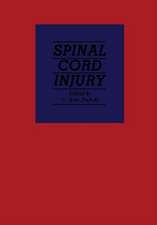Clinical Use of Antibodies: Tumours, infection, infarction, rejection and in the diagnosis of AIDS: Developments in Nuclear Medicine, cartea 19
Editat de Richard P. Baum, P.H. Cox, Gustav Hör, Gian Luigi Buraggien Limba Engleză Paperback – 5 noi 2012
Din seria Developments in Nuclear Medicine
- 5%
 Preț: 346.15 lei
Preț: 346.15 lei - 5%
 Preț: 3201.77 lei
Preț: 3201.77 lei - 5%
 Preț: 1100.09 lei
Preț: 1100.09 lei - 5%
 Preț: 376.43 lei
Preț: 376.43 lei - 5%
 Preț: 2118.14 lei
Preț: 2118.14 lei - 5%
 Preț: 373.68 lei
Preț: 373.68 lei - 5%
 Preț: 1419.03 lei
Preț: 1419.03 lei - 5%
 Preț: 1413.35 lei
Preț: 1413.35 lei - 5%
 Preț: 653.14 lei
Preț: 653.14 lei - 5%
 Preț: 369.65 lei
Preț: 369.65 lei - 5%
 Preț: 717.93 lei
Preț: 717.93 lei - 5%
 Preț: 367.64 lei
Preț: 367.64 lei - 5%
 Preț: 711.32 lei
Preț: 711.32 lei - 5%
 Preț: 2130.92 lei
Preț: 2130.92 lei - 5%
 Preț: 1414.29 lei
Preț: 1414.29 lei - 5%
 Preț: 715.35 lei
Preț: 715.35 lei - 5%
 Preț: 1097.36 lei
Preț: 1097.36 lei - 5%
 Preț: 715.55 lei
Preț: 715.55 lei - 5%
 Preț: 1105.40 lei
Preț: 1105.40 lei - 5%
 Preț: 368.37 lei
Preț: 368.37 lei - 5%
 Preț: 708.23 lei
Preț: 708.23 lei - 5%
 Preț: 1094.80 lei
Preț: 1094.80 lei - 5%
 Preț: 363.44 lei
Preț: 363.44 lei - 5%
 Preț: 1098.12 lei
Preț: 1098.12 lei - 5%
 Preț: 1098.27 lei
Preț: 1098.27 lei - 5%
 Preț: 1100.09 lei
Preț: 1100.09 lei - 5%
 Preț: 1096.10 lei
Preț: 1096.10 lei - 5%
 Preț: 722.33 lei
Preț: 722.33 lei - 5%
 Preț: 363.38 lei
Preț: 363.38 lei - 5%
 Preț: 361.96 lei
Preț: 361.96 lei - 5%
 Preț: 376.43 lei
Preț: 376.43 lei - 15%
 Preț: 588.00 lei
Preț: 588.00 lei - 5%
 Preț: 380.10 lei
Preț: 380.10 lei - 5%
 Preț: 375.34 lei
Preț: 375.34 lei - 5%
 Preț: 369.10 lei
Preț: 369.10 lei
Preț: 710.60 lei
Preț vechi: 748.00 lei
-5% Nou
Puncte Express: 1066
Preț estimativ în valută:
136.02€ • 147.79$ • 114.33£
136.02€ • 147.79$ • 114.33£
Carte tipărită la comandă
Livrare economică 21 aprilie-05 mai
Preluare comenzi: 021 569.72.76
Specificații
ISBN-13: 9789401055550
ISBN-10: 9401055556
Pagini: 200
Ilustrații: X, 185 p.
Dimensiuni: 155 x 235 x 11 mm
Greutate: 0.29 kg
Ediția:Softcover reprint of the original 1st ed. 1991
Editura: SPRINGER NETHERLANDS
Colecția Springer
Seria Developments in Nuclear Medicine
Locul publicării:Dordrecht, Netherlands
ISBN-10: 9401055556
Pagini: 200
Ilustrații: X, 185 p.
Dimensiuni: 155 x 235 x 11 mm
Greutate: 0.29 kg
Ediția:Softcover reprint of the original 1st ed. 1991
Editura: SPRINGER NETHERLANDS
Colecția Springer
Seria Developments in Nuclear Medicine
Locul publicării:Dordrecht, Netherlands
Public țintă
ResearchCuprins
1. Advances in cancer imaging and therapy with radiolabelled antibodies.- 2. Evaluation of the diagnostic utility of immunoscintigraphy in oncology.- 3. The quality control and clinical testing of radiolabelled antibodies.- 4. Clinical utility of radiolabelled monoclonal antibodies in the management of gastrointestinal cancer.- 5. Use of 123-I radiolabelled F(AB’)2 fragments of anti-CEA monoclonal antibody for the detection of primary and metastatic gastrointestinal carcinomas.- 6. Bispecific monoclonal antibodies for two phase radioimmunotherapy.- 7. Antimyosin antibody imaging in myocardial infarction.- 8. Antimyosin based radioimmunodetection of myocarditis cardiomyopathy and cardiac transplant rejection.- 9. Recent advances in the use of radiolabelled monoclonal antibodies in the management of ovarian cancer.- 10. Monoclonal antibodies for cell labelling with particular reference to thrombus imaging.- 11. The role of nuclear medicine in the evaluation of the patient with acquired immune deficiency syndrome (AIDS).- 12. Detection of inflammation/infection using radiolabelled anti-granulocyte antibodies: possibilities and limitations.- 13. A new marker for the detection of adenocardinomas by radioimmunoscintigraphy.- 14. New developments in the diagnosis of AIDS and strategies for therapy.
Recenzii
'To conclude, this is a summary of research findings in Nuclear Medicine of predominant interest to Nuclear Medicine Physicians particularly those interested in "magic bullets", especially biological ones.' Australian Cancer Society 16:3 1992


















